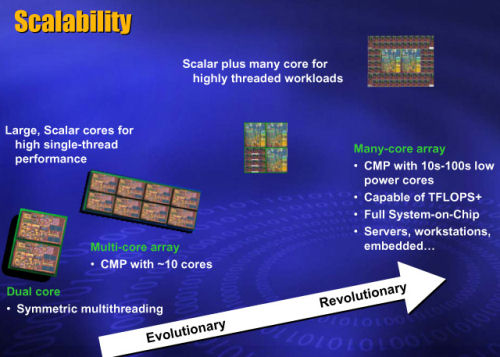Sethamin said:I would disagree with most of the sentiments expressed in this thread. While the trend in hardware will certainly be towards more parallelism, the architecture favored will most likely be symmetric cores like XeCPU. The reason is pretty simple: most general purpose CPUs (e.g. Intel, AMD, IBM Power line) are moving in that direction, and so most likely console CPUs will as well. For starters, there's going to be a lot more research in this area: how you build the microarchitecture, memory systems to keep them properly fed, efficient use of die space and transistors, etc. On top of that, most academic research around parallelizing algorithms target symmetric cores, and will continue to do so in the future.
The CELL is a very interesting idea, but it is an anamoly and it will not take off outside of specialized areas. It would probably not be getting much traction if not for the fact that Sony is pushing it in the PS3. The market can tolerate it now because it is in the middle of the transition away from instruction level parallelism towards thread level parallelism, and everyone is in the midst of adapting (and hence there's no entrenched mindset around that yet). But in the long run, symmetric cores will be the winner. Remember also that PC gaming, while shrinking in size, has massive mindshare among developers. Most console devs started there and still do, and thus symmetric cores will be the path of least resistance and smallest learning curve when transitioning or porting to a console.
I think Cell in PS4 - assuming again no paradigm shift occurs - makes a lot of sense if only because developers will already be familiar with the architecture, and it doesn't behoove Sony to move them away from that if they feel performance-wise it is still viable. Personally, I think there is still going to be a lot to be gained on the CPU side of things as non-graphics tasks get their importance upped this gen. The preceding comments also haven't been focused on whether or not an XeCPU-like architecture is viable in the long run (if you're talking symmetric cores), but rather if the XeCPU *itself* is viable in the long run; and I simply believe five years from now there will probably be a better option available to Microsoft than an XeCPU with nine cores at 6 GHz.
The 'larger picture' aside however, I think the future of Cell's vision involves an abstraction as to the number of cores/SPE's available for work, with the tool and programming models heavily favoring breaking code down to put on the SPE's. Anything that can go on them, will - even if they are not the best suited architecture to handle it. Five/six years down the line, regardless of what new architecture Sony could go with - I think it would truly have to be something special in order to warrant turning the development community on it's head, for exotic though the 1:8 model might be, it will be a model with which a great many game developers will be familiar with at that point.
This is also not taking into account that a cottage base of programmers might gravitate towards Cell for the defense and imaging fields in the same way that Itanium/Epic - though niche - has it's adherents as well.

